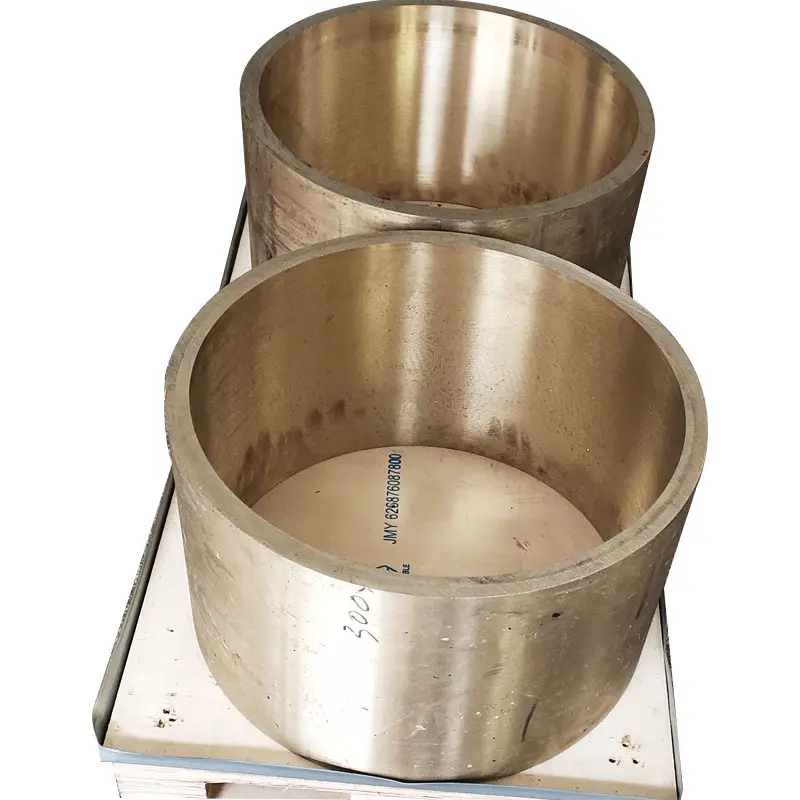
Giới thiệu
Aluminum bronze pipes have gained significant popularity in various industries due to their exceptional combination of strength, corrosion resistance, and durability. This comprehensive guide explores the characteristics, applications, manufacturing processes, and maintenance of aluminum bronze pipes, providing valuable insights for engineers, procurement specialists, and industry professionals.
Composition and Properties
Aluminum bronze pipes are copper-based alloys containing aluminum as the primary alloying element. The addition of aluminum significantly enhances the material’s properties, making it suitable for demanding applications.
Thành phần hóa học
The typical composition of aluminum bronze pipes varies depending on the specific grade. Here’s a table showing the composition of common aluminum bronze alloys used for pipes:
| Hợp kim | Cu (%) | Al (%) | Fe (%) | Ni (%) | Mn (%) | Other (%) |
|---|---|---|---|---|---|---|
| C95200 | 86-89 | 8,5-9,5 | 2.5-4.0 | - | - | 0tối đa 0,25 |
| C95400 | 85-89 | 10-11,5 | 3.0-5.0 | - | 0tối đa 0,5 | 0tối đa 0,25 |
| C95500 | 78-82 | 10-11,5 | 3,5-4,5 | 4.0-5.0 | 0tối đa 0,5 | 0tối đa 0,25 |
| C95800 | 79-82 | 8,5-9,5 | 3,5-4,5 | 4.0-5.0 | 0.8-1.5 | 0tối đa 0,25 |
Thuộc tính chính
Aluminum bronze pipes offer a unique set of properties that make them ideal for various applications:
- Chống ăn mòn: Excellent resistance to seawater, brackish water, and many chemicals.
- Cường độ cao: Superior strength compared to standard copper alloys.
- Hao mòn điện trở: Good resistance to abrasion and erosion.
- Dẫn nhiệt: Moderate thermal conductivity, better than stainless steel.
- Non-sparking: Suitable for use in explosive environments.
- Biofouling Resistance: Naturally resistant to marine growth.
Các ứng dụng
Aluminum bronze pipes find applications across various industries due to their unique properties. Here’s a table summarizing key applications:
| Ngành công nghiệp | Các ứng dụng |
|---|---|
| Hàng hải | Seawater piping systems, propeller shafts, pump casings |
| Oil & Gas | Offshore platforms, subsea equipment, valve bodies |
| Xử lý hóa chất | Heat exchangers, reaction vessels, distillation columns |
| Sản xuất điện | Condenser tubes, cooling water systems, valve components |
| Không gian vũ trụ | Hydraulic systems, landing gear components |
| Mining | Slurry pipelines, pump components, screening equipment |
Case Study: Seawater Cooling Systems
In a notable application, a coastal power plant replaced its stainless steel seawater cooling pipes with C95800 aluminum bronze pipes. The results were impressive:
- 40% reduction in maintenance costs
- 25% increase in heat transfer efficiency
- Extended system lifespan from 15 to 25 years
Quy trình sản xuất
Aluminum bronze pipes are manufactured using various processes to meet specific requirements:
- Centrifugal Casting: Ideal for large diameter pipes with excellent dimensional accuracy.
- Mỗi loại phục vụ một ứng dụng khác nhau: Suitable for smaller diameter pipes with consistent wall thickness.
- Continuous Casting: Efficient for high-volume production of standard sizes.
- Welded Fabrication: Custom shapes and sizes for specialized applications.
Quality Control Measures
To ensure the highest quality, manufacturers implement rigorous quality control measures:
- Non-destructive testing (NDT) methods such as ultrasonic testing and radiography
- Chemical composition analysis using spectrometry
- Mechanical property testing including tensile strength and hardness tests
- Dimensional inspections and tolerance checks
Selection Guide
Choosing the right aluminum bronze pipe for your application involves considering several factors:
- Operating Environment: Consider factors like temperature, pressure, and chemical exposure.
- Mechanical Requirements: Evaluate strength, hardness, and wear resistance needs.
- Chống ăn mòn: Assess the specific corrosive agents present in the application.
- Cân nhắc chi phí: Balance initial costs with long-term performance and maintenance savings.
Comparison with Other Materials
Here’s a comparison table of aluminum bronze pipes with other common piping materials:
| Tài sản | Nhôm đồng | Thép không gỉ | Thép carbon | Copper-Nickel |
|---|---|---|---|---|
| Chống ăn mòn | Xuất sắc | Tốt | Nghèo | Rất tốt |
| Sức lực | Cao | Cao | Vừa phải | Vừa phải |
| Tốc độ dao động từ bảy mảnh mỗi phút đối với máy âm lượng thấp đến | Cao | Vừa phải | Low | Vừa phải |
| Trọng lượng | Vừa phải | Cao | Cao | Vừa phải |
| Dẫn nhiệt | Vừa phải | Low | Cao | Vừa phải |
| Biofouling Resistance | Xuất sắc | Nghèo | Nghèo | Tốt |
Installation and Maintenance
Proper installation and maintenance are crucial for maximizing the performance and lifespan of aluminum bronze pipes:
Installation Best Practices
- Use compatible fittings and gaskets to prevent galvanic corrosion.
- Implement proper support and anchoring to minimize stress on the pipes.
- Follow recommended welding procedures if joining is required.
- Conduct thorough flushing and cleaning before commissioning.
Maintenance Tips
- Regular inspections for signs of wear or corrosion
- Proper cleaning to remove marine growth or scale buildup
- Cathodic protection systems for submerged applications
- Monitoring of water chemistry in cooling systems
Future Trends
The aluminum bronze pipe industry is evolving with new trends and innovations:
- Advanced Alloys: Development of new aluminum bronze compositions with enhanced properties.
- Additive Manufacturing: Exploration of 3D printing techniques for complex pipe geometries.
- Smart Piping Systems: Integration of sensors for real-time monitoring and predictive maintenance.
- Sustainable Production: Focus on recycling and eco-friendly manufacturing processes.
Phần kết luận
Aluminum bronze pipes offer a compelling combination of properties that make them ideal for challenging applications across various industries. By understanding their characteristics, manufacturing processes, and selection criteria, engineers and procurement specialists can make informed decisions to optimize performance and cost-effectiveness in their piping systems.
As the industry continues to evolve, aluminum bronze pipes are likely to play an increasingly important role in addressing the demands of modern industrial applications, particularly in corrosive and high-stress environments.
